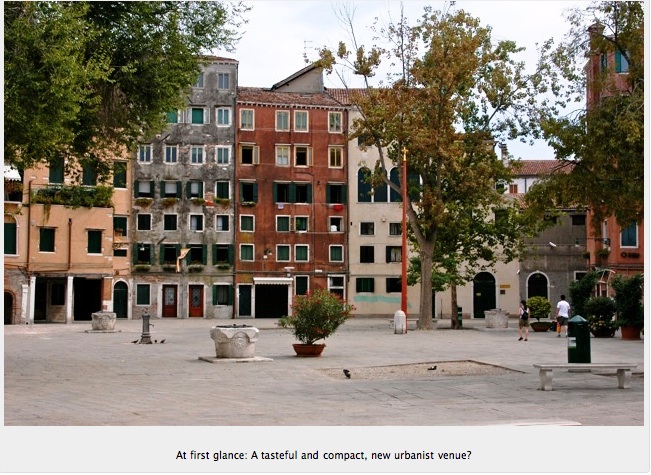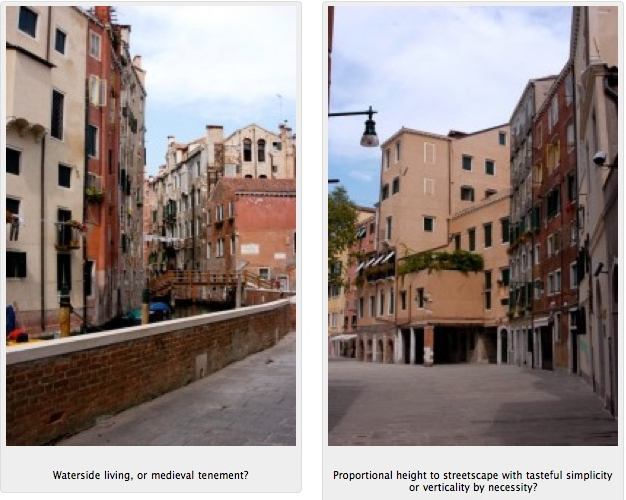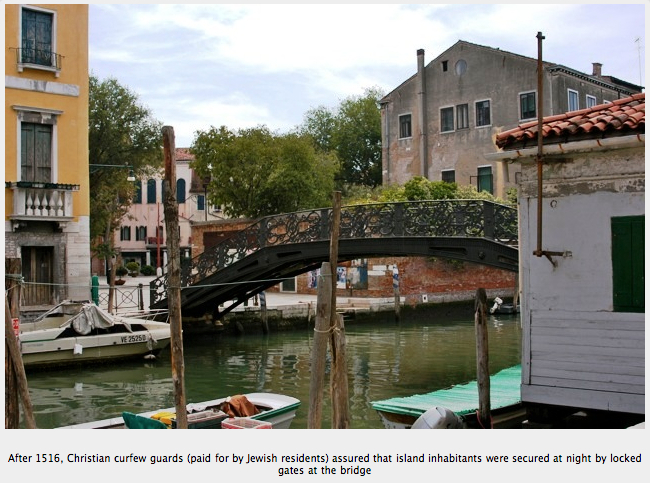
The urban scene above is where "small-g" ghettos come from, the Ghetto in the Cannareggio section of Venice. This small island, with seven-story "high-rises" dictated by necessity, became the namesake of overcrowded and segregated urban neighborhoods around the world.
Yet, at the same time, from its roots in the sixteenth century to the present, the Ghetto has featured the compact, dense, walkable core -- the urban form fancied as the antidote to sprawl -- with qualities central to mainstream urban reinvention today.
Are there risks of a "one size fits all" approach to reshaping our cities, and making new, sustainable places? Many have asked before -- from those who accuse the "new urbanist" movement of an overly nostalgic "historic amnesia" to earlier, social engineering-based critics of the "neighborhood unit" theory. However, few if any provided such a direct and ironic photographic illustration of an undesired land use and societal outcome.

These ironic photographs are not so much a tool to criticize goals, but to advance a cautionary essay, an illustration to assure we remain mindful of the task at hand -- to provide more livable cities and more sustainable forms of development.
As Christopher Leinberger recently recalled in the New Republic, simply referencing "cities versus suburbs" is an incomplete debate. An overemphasis on spatial outcomes and vague descriptors, without more, risks only polemic debates of urban vs. suburban choice, and the virtues of urban alleys vs. sprawl and cul-de-sacs.

In foretelling the "landscape" vs. "new" urbanist debates of the past year, Australian urban designer Ruth Durack suggested early in the last decade (with a passing reference to the Venetian Ghetto) that the urban village is dictated by a rigid form and function which clashes with fundamental principles of sustainability.
Durack argued for a more free form of planning which recognizes multiple, interactive systems which cannot be dictated by static physical models, premised on the "cultures" of green (e.g., agri-, perma- and aqua-). She provided a pragmatic focus by stressing commencement of sustainable community planning with a specific strategic act or project, such as a housing start, rather than imposition of a village plan.
The strategic act, she noted, should feature dynamic citizen input, and accept the unpredictability and discontinuities of American urban evolution. Durack's emphasis was a careful undressing of "new urbanism": without an awareness of urban ecology and a strategic input, the urban village may be little more than a dangerous "chimera" -- a code word for impossible fantasy.
As amplified last month by Roger Lewis in the Washington Post and Kaid Benfield in The Atlantic, we need guiding "live-work" principles and templates for the compact, walkable, transit-based communities which frame emerging urban policy.
But we also need to keep a contextual eye on the prize. Integration of local values and preferences is a central aspect of the public process and is critical to the creation of unique communities.
For instance, as we concluded in a recent study of barriers to transit-oriented development in Washington State, silo-specific orientations often fail to discern the wide variety of investments, regulations, policies, financing mechanisms and public outreach needed for developing alternatives to conventional auto-centric development.
The point: continue to track context over catchwords. In another place at another time, the virtues of compact, walkable and dense were the very isolation we now abhor.
All photographs composed by the author.
Cross-posted and revised from the original, which appeared in myurbanist, Sustainable Cities Collective and was adapted for use in Real Estate Law & Industry Report.
